Abstract
The effect of circulating passive antibody on immunity to bovine rotavirus infections in neonatal calves was investigated. In the first experiment, rotavirus antibody titers in the small intestinal lumina of 5- and 10-day-old calves with a wide range of serum rotavirus antibody titers were determined. Neutralizing antibody was present in the small intestinal lumina in titers that correlated with the calves' serum titers (r = +0.84, P less than 0.01). Immunoglobulin G1 was the predominant isotype of intestinal luminal rotavirus antibody. Calves not fed colostrum during the absorptive period lacked rotavirus antibody in circulation and in the intestinal lumen at 7 days of age, even when they were fed large volumes of colostrum with a high rotavirus antibody titer at 48 h after birth. Therefore, rotavirus antibody is not retained in the intestinal lumen for 5 days following a colostrum meal, and the luminal antibody in the 5- and 10-day-old seropositive calves were probably derived from circulating antibody. In a second experiment, calves were passively immunized by subcutaneous injection of colostral whey with a high immunoglobulin G1 rotavirus antibody titer and challenged with virulent bovine rotavirus 48 h later. The passively immunized calves were protected from rotavirus infection and diarrhea compared with calves with comparable serum immunoglobulin concentrations but with lower serum rotavirus with lower serum rotavirus antibody titers. The results of these experiments indicate that circulating immunoglobulin G1 antibody appears in the gastrointestinal tract of neonatal calves and that circulating rotavirus antibody can prevent infection and diarrhea after rotavirus challenge.
Full text
PDF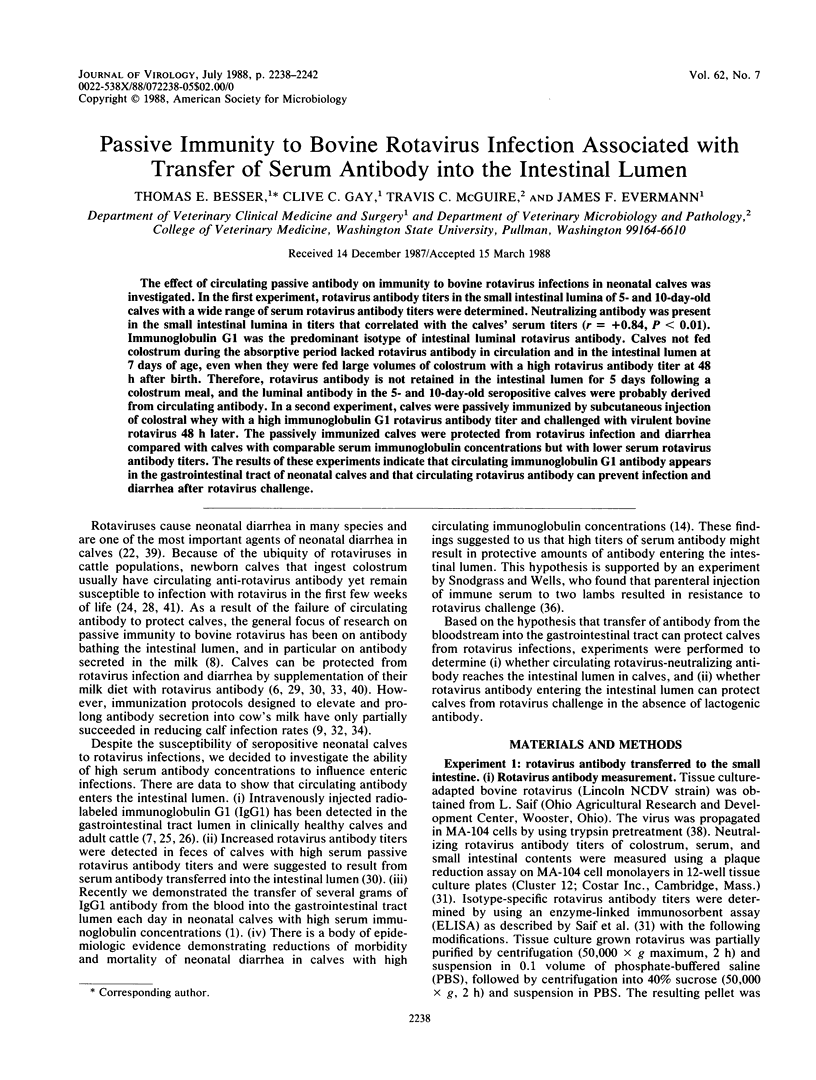
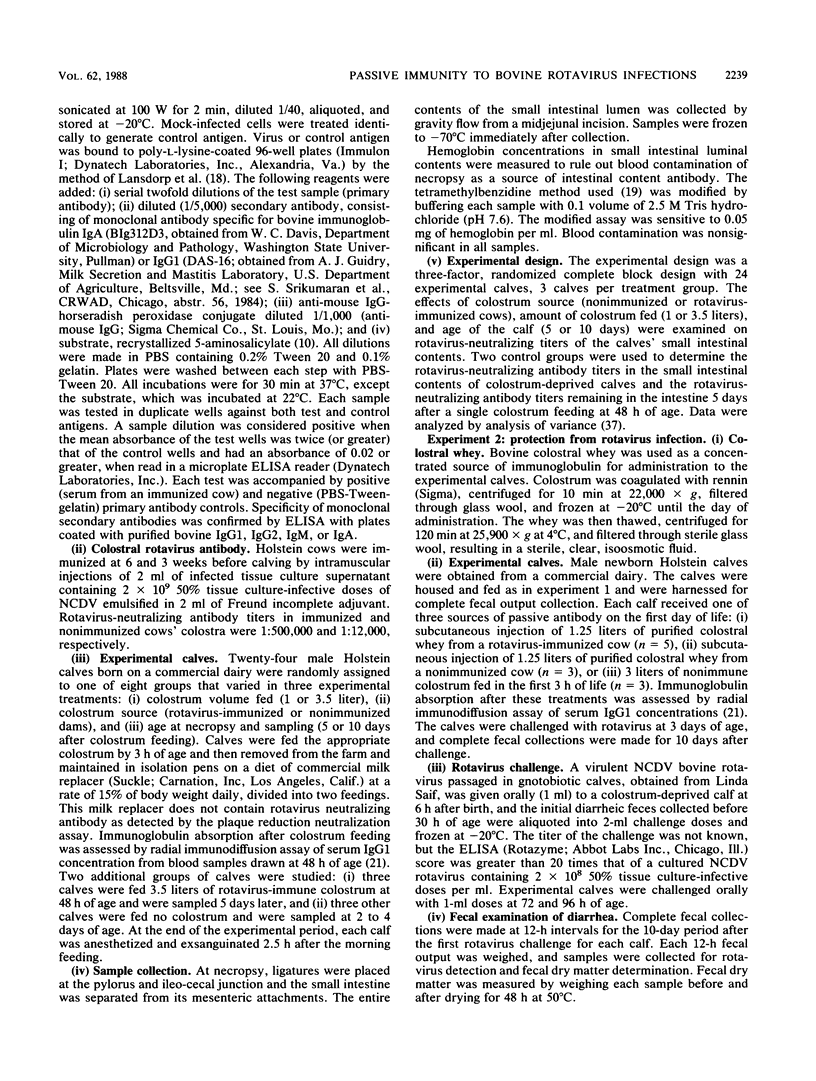
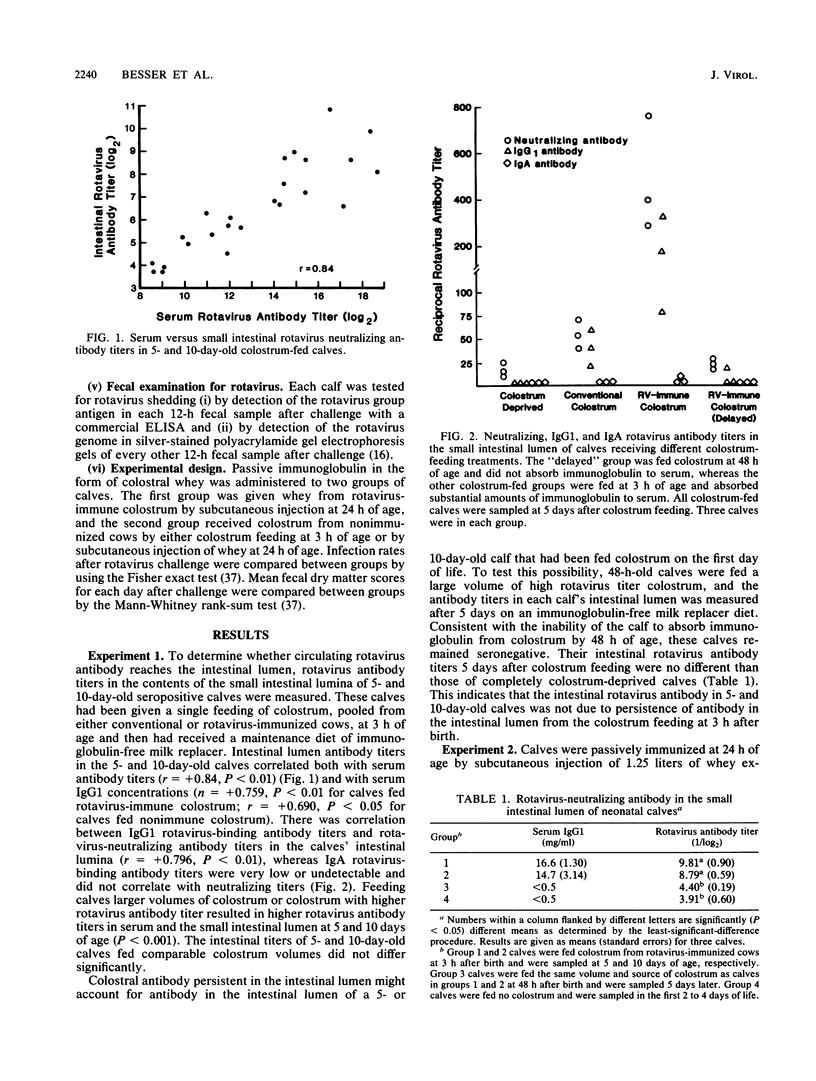
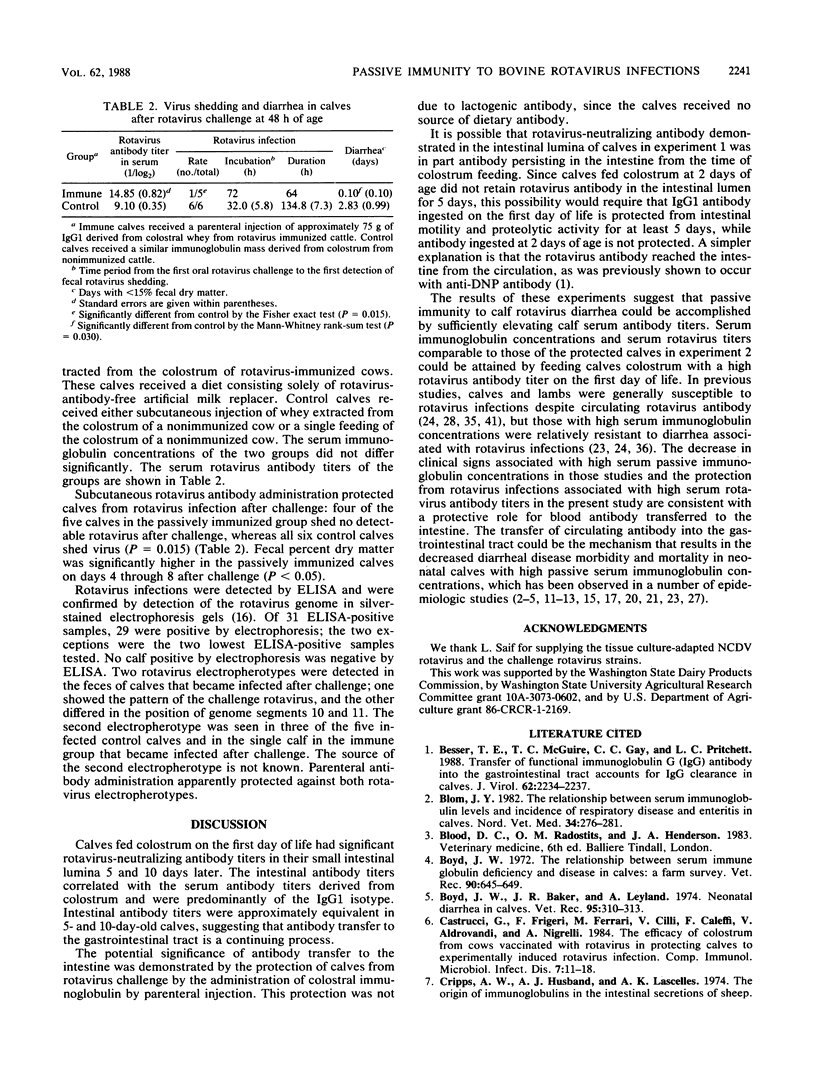
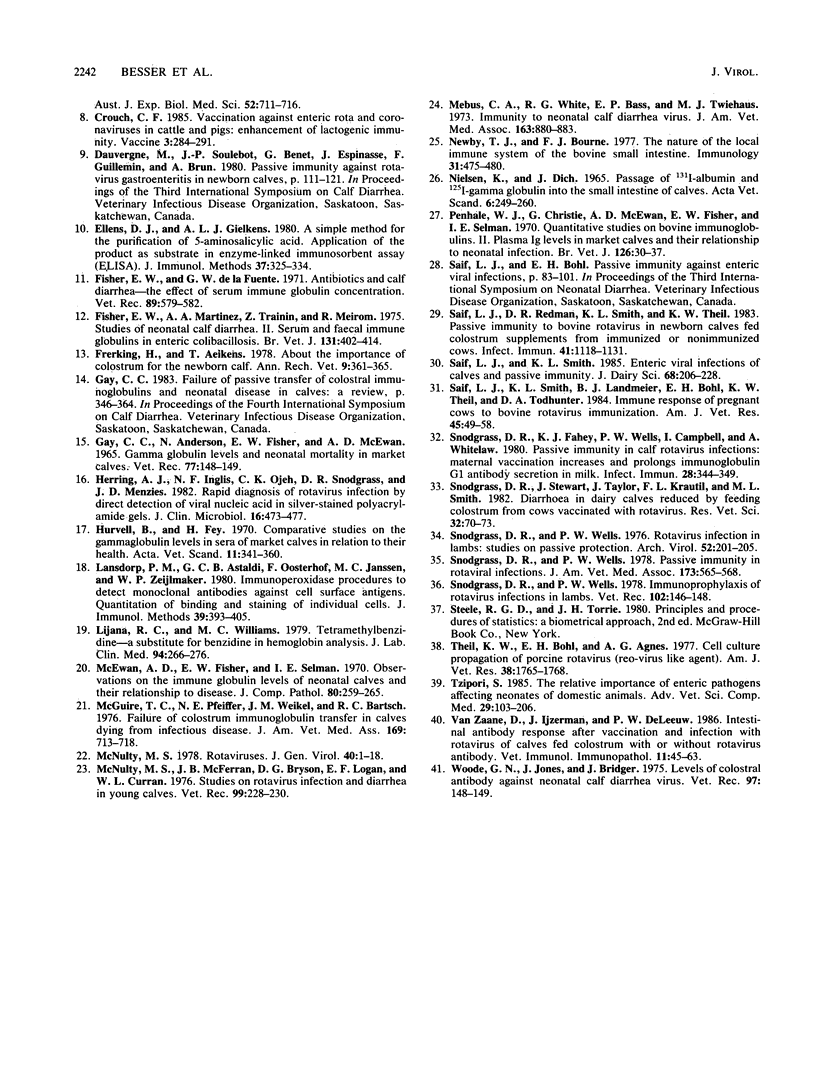
Selected References
These references are in PubMed. This may not be the complete list of references from this article.
- Besser T. E., McGuire T. C., Gay C. C., Pritchett L. C. Transfer of functional immunoglobulin G (IgG) antibody into the gastrointestinal tract accounts for IgG clearance in calves. J Virol. 1988 Jul;62(7):2234–2237. doi: 10.1128/jvi.62.7.2234-2237.1988. [DOI] [PMC free article] [PubMed] [Google Scholar]
- Blom J. Y. The relationship between serum immunoglobulin values and incidence of respiratory disease and enteritis in calves. Nord Vet Med. 1982 Jul-Sep;34(7-9):276–284. [PubMed] [Google Scholar]
- Boyd J. W., Baker J. R., Leyland A. Neonatal diarrhoea in calves. Vet Rec. 1974 Oct 5;95(14):310–313. doi: 10.1136/vr.95.14.310. [DOI] [PubMed] [Google Scholar]
- Boyd J. W. The relationship between serum immune globulin deficiency and disease in calves: a farm survey. Vet Rec. 1972 Jun 3;90(23):645–649. doi: 10.1136/vr.90.23.645. [DOI] [PubMed] [Google Scholar]
- Castrucci G., Frigeri F., Ferrari M., Cilli V., Caleffi F., Aldrovandi V., Nigrelli A. The efficacy of colostrum from cows vaccinated with rotavirus in protecting calves to experimentally induced rotavirus infection. Comp Immunol Microbiol Infect Dis. 1984;7(1):11–18. doi: 10.1016/0147-9571(84)90011-0. [DOI] [PubMed] [Google Scholar]
- Crouch C. F. Vaccination against enteric rota and coronaviruses in cattle and pigs: enhancement of lactogenic immunity. Vaccine. 1985 Sep;3(3):284–291. doi: 10.1016/S0264-410X(85)90056-8. [DOI] [PMC free article] [PubMed] [Google Scholar]
- Ellens D. J., Gielkens A. L. A simple method for the purification of 5-aminosalicylic acid. Application of the product as substrate in enzyme-linked immunosorbent assay (ELISA). J Immunol Methods. 1980;37(3-4):325–332. doi: 10.1016/0022-1759(80)90318-x. [DOI] [PubMed] [Google Scholar]
- Fisher E. W., De la Fuente G. H. Antibiotics and calf diarrhoea--the effect of serum immune globulin concentrations. Vet Rec. 1971 Nov 27;89(22):579–582. doi: 10.1136/vr.89.22.579. [DOI] [PubMed] [Google Scholar]
- Fisher E. W., Martinez A. A., Trainin Z., Meirom R. Studies of neonatal calf diarrhoea. II. Serum and faecal immune globulins in enteric colibacillosis. Br Vet J. 1975 Jul-Aug;131(4):402–415. doi: 10.1016/s0007-1935(17)35236-3. [DOI] [PubMed] [Google Scholar]
- Frerking H., Aeikens T. About the importance of colostrum for the newborn calf. Ann Rech Vet. 1978;9(2):361–365. [PubMed] [Google Scholar]
- GAY C. C., ANDERSON N., FISHER N., FISHER E. W., MCEWAN A. D. GAMMA GLOBULIN LEVELS AND NEONATAL MORTALITY IN MARKET CALVES. Vet Rec. 1965 Jan 30;77:148–149. [PubMed] [Google Scholar]
- Herring A. J., Inglis N. F., Ojeh C. K., Snodgrass D. R., Menzies J. D. Rapid diagnosis of rotavirus infection by direct detection of viral nucleic acid in silver-stained polyacrylamide gels. J Clin Microbiol. 1982 Sep;16(3):473–477. doi: 10.1128/jcm.16.3.473-477.1982. [DOI] [PMC free article] [PubMed] [Google Scholar]
- Hurvell B., Fey H. Comparative studies on the gammaglobulin level in sera of market calves in relation to their health. Acta Vet Scand. 1970;11(3):341–360. doi: 10.1186/BF03547962. [DOI] [PMC free article] [PubMed] [Google Scholar]
- Lansdorp P. M., Astaldi G. C., Oosterhof F., Janssen M. C., Zeijlemaker W. P. Immunoperoxidase procedures to detect monoclonal antibodies against cell surface antigens. Quantitation of binding and staining of individual cells. J Immunol Methods. 1980;39(4):393–405. doi: 10.1016/0022-1759(80)90240-9. [DOI] [PubMed] [Google Scholar]
- Lijana R. C., Williams M. C. Tetramethylbenzidine--a substitute for benzidine in hemoglobin analysis. J Lab Clin Med. 1979 Aug;94(2):266–276. [PubMed] [Google Scholar]
- McEwan A. D., Fisher E. W., Selman I. E. Observations on the immune globulin levels of neonatal calves and their relationship to disease. J Comp Pathol. 1970 Apr;80(2):259–265. doi: 10.1016/0021-9975(70)90093-9. [DOI] [PubMed] [Google Scholar]
- McGuire T. C., Pfeiffer N. E., Weikel J. M., Bartsch R. C. Failure of colostral immunoglobulin transfer in calves dying from infectious disease. J Am Vet Med Assoc. 1976 Oct 1;169(7):713–718. [PubMed] [Google Scholar]
- McNulty M. S., McFerran J. B., Bryson D. G., Logan E. F., Curran W. L. Studies on rotavirus infection and diarrhoea in young calves. Vet Rec. 1976 Sep 18;99(12):229–230. doi: 10.1136/vr.99.12.229. [DOI] [PubMed] [Google Scholar]
- Newby T. J., Bourne F. J. The nature of the local immune system of the bovine small intestine. Immunology. 1976 Sep;31(3):475–480. [PMC free article] [PubMed] [Google Scholar]
- Nielsen K., Dich J. Passage of I-131-albumin and I-125-gamma globulin into the small intestine of calves. Acta Vet Scand. 1965;6(3):249–260. doi: 10.1186/BF03547082. [DOI] [PMC free article] [PubMed] [Google Scholar]
- Penhale W. J., Christie G., McEwan A. D., Fisher E. W., Selman I. E. Quantitative studies on bovine immunoglobulins. II. Plasma immunoglobulin levels in market calves and their relationship to neonatal infection. Br Vet J. 1970 Jan;126(1):30–37. [PubMed] [Google Scholar]
- Saif L. J., Redman D. R., Smith K. L., Theil K. W. Passive immunity to bovine rotavirus in newborn calves fed colostrum supplements from immunized or nonimmunized cows. Infect Immun. 1983 Sep;41(3):1118–1131. doi: 10.1128/iai.41.3.1118-1131.1983. [DOI] [PMC free article] [PubMed] [Google Scholar]
- Saif L. J., Smith K. L. Enteric viral infections of calves and passive immunity. J Dairy Sci. 1985 Jan;68(1):206–228. doi: 10.3168/jds.S0022-0302(85)80813-4. [DOI] [PMC free article] [PubMed] [Google Scholar]
- Saif L. J., Smith K. L., Landmeier B. J., Bohl E. H., Theil K. W., Todhunter D. A. Immune response of pregnant cows to bovine rotavirus immunization. Am J Vet Res. 1984 Jan;45(1):49–58. [PubMed] [Google Scholar]
- Snodgrass D. R., Fahey K. J., Wells P. W., Campbell I., Whitelaw A. Passive immunity in calf rotavirus infections: maternal vaccination increases and prolongs immunoglobulin G1 antibody secretion in milk. Infect Immun. 1980 May;28(2):344–349. doi: 10.1128/iai.28.2.344-349.1980. [DOI] [PMC free article] [PubMed] [Google Scholar]
- Snodgrass D. R., Stewart J., Taylor J., Krautil F. L., Smith M. L. Diarrhoea in dairy calves reduced by feeding colostrum from cows vaccinated with rotavirus. Res Vet Sci. 1982 Jan;32(1):70–73. doi: 10.1016/S0034-5288(18)32440-8. [DOI] [PMC free article] [PubMed] [Google Scholar]
- Snodgrass D. R., Wells P. W. Passive immunity in rotaviral infections. J Am Vet Med Assoc. 1978 Sep 1;173(5 Pt 2):565–568. [PubMed] [Google Scholar]
- Snodgrass D. R., Wells P. W. Rotavirus infection in lambs: studies on passive protection. Arch Virol. 1976;52(3):201–205. doi: 10.1007/BF01348017. [DOI] [PubMed] [Google Scholar]
- Snodgrass D. R., Wells P. W. The immunoprophylaxis of of rotavirus infections in lambs. Vet Rec. 1978 Feb 18;102(7):146–148. doi: 10.1136/vr.102.7.146. [DOI] [PubMed] [Google Scholar]
- Theil K. W., Bohl E. H., Agnes A. G. Cell culture propagation of porcine rotavirus (reovirus-like agent). Am J Vet Res. 1977 Nov;38(11):1765–1768. [PubMed] [Google Scholar]
- Tzipori S. The relative importance of enteric pathogens affecting neonates of domestic animals. Adv Vet Sci Comp Med. 1985;29:103–206. [PubMed] [Google Scholar]
- Van Zaane D., Ijzerman J., De Leeuw P. W. Intestinal antibody response after vaccination and infection with rotavirus of calves fed colostrum with or without rotavirus antibody. Vet Immunol Immunopathol. 1986 Jan;11(1):45–63. doi: 10.1016/0165-2427(86)90087-5. [DOI] [PMC free article] [PubMed] [Google Scholar]
- Woode G. N., Jones J., Bridger J. Levels of colostral antibodies against neonatal calf diaahoea virus. Vet Rec. 1975 Aug 23;97(8):148–149. doi: 10.1136/vr.97.8.148. [DOI] [PubMed] [Google Scholar]


